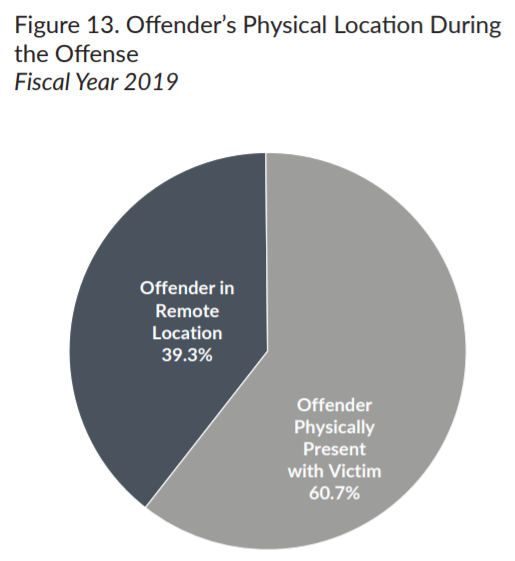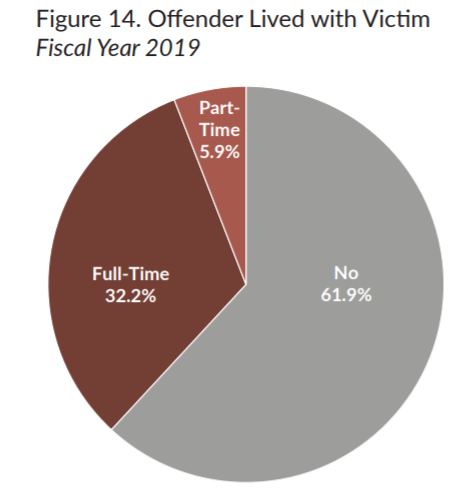
Child Sex Abuse Material Production Sentencing Is On The Rise
By a Biometrica staffer
Out of the total federal caseload, child sex abuse material (CSAM) production cases account for only a small percentage. Even so, the expansion of digital and mobile technology has led to a 422% spike in the number of CSAM production offenders sentenced over a 15-year period, from 98 offenders in fiscal year 2005 to 512 in fiscal year 2019, according to a new report published by the United States Sentencing Commission (USSC). With technological advancements, offenders have gained easier access to victims. Meanwhile, the prevalence of smartphones with built-in cameras and expansive storage has also been misused by offenders.
In 2020 alone, the Cyber Tipline of the National Center for Missing and Exploited Children (NCMEC) received 21.7 million reports of child sexual abuse imagery, online child exploitation and enticement, child sexual molestation, and child sex trafficking. Some of the issues discussed by the USSC in its 2012 Child Pornography Report persist even today, including: the continued growth in the number of CSAM production cases, the volume and accessibility of CSAM images due to advancements in technology, and the resulting lengthy sentences for CSAM production offenders.
CSAM production offenders generally received lengthy sentences per the latest USSC report too. In fiscal year 2019, production offenders received an average sentence of almost 23 years, ranging in length from one year to life imprisonment. Emerging technology continues to be used to create greater opportunity for CSAM production offenders to access and exploit minor victims. As computers and mobile devices offer video capabilities and live streaming functions, some offenders produce CSAM from remote locations away from the victim.
In this piece, we take a look at the other key findings of the USSC report, from the physical proximity and relationship between offenders and victims, to offender behavior, offense characteristics, and victim characteristics.
Before we get into details of the report, though, we pause here to make a note that the official legal term — also used by the USSC — is “child pornography.” However, there is a growing movement to change the name of this category to “child sexual abuse material” because, by virtue of their age, children cannot consent to being part of any pornographic material.
Offender Proximity To Victims


According to the report, a majority of CSAM production offenders maintained a position of trust over their victims, whether through familial relationships or by virtue of the offender’s role as a teacher or a coach, for example. Roughly 60% of the offenders in the fiscal year 2019 produced CSAM in the same location as the victim. However, given advancements in technology and social media use by both offenders and minors, close physical proximity is no longer necessary for offenders to produce CSAM.
An increasing number of offenders exploited victims remotely through the internet or the use of mobile technology to produce CSAM. Even so, the report’s findings showed that offenders who appeared to have the closest proximity and communicated with their victims in person generally committed the production offense with the youngest victims. Such offenders also appeared to have had sexual contact with the victims in most cases.
Among offenders who initiated communication with their victims in person, the youngest victims for nearly one-third (30.3%) of offenders were infants or toddlers, and slightly more than half (53.2%) were prepubescent (age 4 to 12). The youngest victims for nearly two-thirds (61.7%) of offenders who communicated with victims remotely were teenagers, who were more likely to have access to the internet, cell phones, and/or social media. The youngest victims for more than one-third of offenders who communicated with victims remotely were prepubescent (36.5%).
The report also shows that a majority of the offenders were related to or otherwise maintained a position of trust over a minor victim as a family member or through some other close relationship. This category could include parents, legal guardians or step-parents, other relatives, a parent’s intimate partner, family friends, teachers, etc. But, the single largest individual category of CSAM offenders were internet strangers who met their victims through an online or remote platform.
About half of all fiscal year 2019 CSAM production offenders communicated with a victim in person. Notably, 19.3% of offenders surreptitiously recorded a victim to produce CSAM and, thus, did not communicate with that victim either in person or remotely.
Nearly half (47.1%) of all production offenders sentenced in fiscal year 2019 used a smartphone or tablet to create CSAM images or videos. A substantial minority of offenders (36.5%) had victims create content at their request. In 11.9% of the cases, the offenders used a livestreaming platform or web camera to produce CSAM. Most CSAM production offenders (83.8%) committed the offense alone, but 16.2% of offenders committed the offense with an adult co-participant.
Offender & Victim Characteristics
CSAM production offenders tend to be racially homogenous, have higher levels of education, and have limited or no prior criminal histories. Most fiscal year 2019 production offenders were white (75.2%) and nearly all were U.S. citizens (95.5%) and male (94.3%). This contrasts with all other federal offenders, who were 19.9% white, 56.3% U.S. citizens, and 87.8% male.
The average age of CSAM production offenders sentenced was 38 years old, only one year older than the average age of all other federal offenders sentenced the same year. CSAM production offenders generally attained a higher degree of education than all other offenders, with just under half (48.4%) of production offenders having attended college compared to about one-fifth (21.1%) of all other offenders.
CSAM production offenders also have less extensive criminal histories compared with other federal offenders. In fiscal year 2019, 70.3% of CSAM production offenders were assigned to Criminal History Category I (the lowest category, requiring no more than one criminal history point). By contrast, only 44.2% of all other federal offenders were assigned to Criminal History Category I. To add further context, a majority (60.7%) of CSAM production offenders had zero criminal history points compared to one-third (33.4%) of all other offenders sentenced in fiscal year 2019.

In fiscal year 2019, all CSAM production offenders were sentenced to a term of imprisonment. Sentences ranged from one year to life, with an average sentence of 275 months. More than three-quarters (78.0%) of the offenders were convicted under a statute that carries at least a 15-year mandatory minimum penalty. The average guideline minimum for CSAM production offenders has increased steadily over time, from an average of 273 months in fiscal year 2005 to an average of 332 months in fiscal year 2019.
The number of CSAM production victims involved in a single offense in fiscal year 2019 ranged from one to 440. A majority of cases involved a single victim, but a substantial majority had more than one minor victim. The average age of the youngest minor victim was 10 years. In over 60% of cases, the youngest victim was 12 years or younger, and 16.8% of cases involved an infant or a toddler. In nearly 40% of the cases in fiscal 2019, the youngest victim was a teenager (13–17 years old). Three-quarters of the CSAM production victims involved only female victims in fiscal 2019.